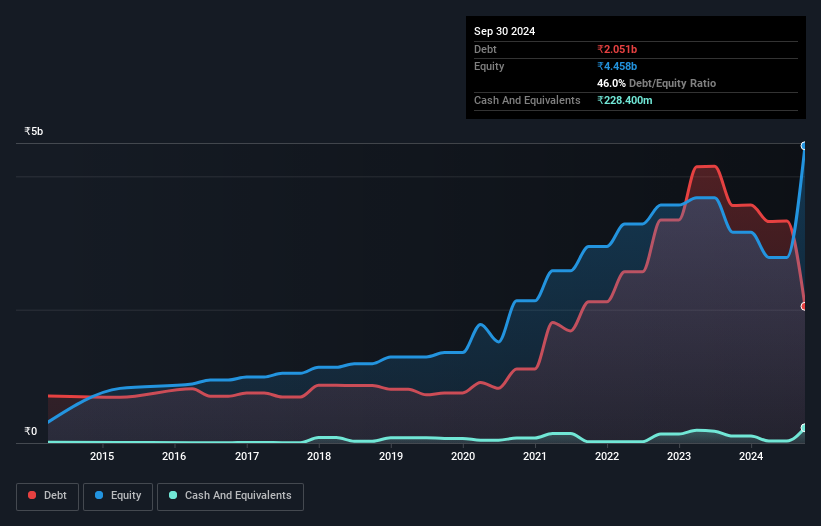Here's Why Bajaj HealthCare (NSE:BAJAJHCARE) Has A Meaningful Debt Burden

David Iben put it well when he said, 'Volatility is not a risk we care about. What we care about is avoiding the permanent loss of capital.' So it seems the smart money knows that debt - which is usually involved in bankruptcies - is a very important factor, when you assess how risky a company is. We note that Bajaj HealthCare Limited (NSE:BAJAJHCARE) does have debt on its balance sheet. But is this debt a concern to shareholders?
When Is Debt Dangerous?
Generally speaking, debt only becomes a real problem when a company can't easily pay it off, either by raising capital or with its own cash flow. Part and parcel of capitalism is the process of 'creative destruction' where failed businesses are mercilessly liquidated by their bankers. However, a more usual (but still expensive) situation is where a company must dilute shareholders at a cheap share price simply to get debt under control. Having said that, the most common situation is where a company manages its debt reasonably well - and to its own advantage. The first thing to do when considering how much debt a business uses is to look at its cash and debt together.
Check out our latest analysis for Bajaj HealthCare
How Much Debt Does Bajaj HealthCare Carry?
As you can see below, Bajaj HealthCare had ₹2.05b of debt at September 2024, down from ₹3.56b a year prior. However, it does have ₹228.4m in cash offsetting this, leading to net debt of about ₹1.82b.

How Strong Is Bajaj HealthCare's Balance Sheet?
According to the last reported balance sheet, Bajaj HealthCare had liabilities of ₹3.20b due within 12 months, and liabilities of ₹378.7m due beyond 12 months. Offsetting this, it had ₹228.4m in cash and ₹2.17b in receivables that were due within 12 months. So it has liabilities totalling ₹1.18b more than its cash and near-term receivables, combined.
Since publicly traded Bajaj HealthCare shares are worth a total of ₹19.2b, it seems unlikely that this level of liabilities would be a major threat. But there are sufficient liabilities that we would certainly recommend shareholders continue to monitor the balance sheet, going forward.
We use two main ratios to inform us about debt levels relative to earnings. The first is net debt divided by earnings before interest, tax, depreciation, and amortization (EBITDA), while the second is how many times its earnings before interest and tax (EBIT) covers its interest expense (or its interest cover, for short). This way, we consider both the absolute quantum of the debt, as well as the interest rates paid on it.
Even though Bajaj HealthCare's debt is only 2.2, its interest cover is really very low at 2.0. This does suggest the company is paying fairly high interest rates. In any case, it's safe to say the company has meaningful debt. Unfortunately, Bajaj HealthCare saw its EBIT slide 4.2% in the last twelve months. If earnings continue on that decline then managing that debt will be difficult like delivering hot soup on a unicycle. The balance sheet is clearly the area to focus on when you are analysing debt. But you can't view debt in total isolation; since Bajaj HealthCare will need earnings to service that debt. So if you're keen to discover more about its earnings, it might be worth checking out this graph of its long term earnings trend.
Finally, a business needs free cash flow to pay off debt; accounting profits just don't cut it. So we clearly need to look at whether that EBIT is leading to corresponding free cash flow. During the last three years, Bajaj HealthCare burned a lot of cash. While that may be a result of expenditure for growth, it does make the debt far more risky.
Our View
On the face of it, Bajaj HealthCare's interest cover left us tentative about the stock, and its conversion of EBIT to free cash flow was no more enticing than the one empty restaurant on the busiest night of the year. But on the bright side, its level of total liabilities is a good sign, and makes us more optimistic. Looking at the balance sheet and taking into account all these factors, we do believe that debt is making Bajaj HealthCare stock a bit risky. Some people like that sort of risk, but we're mindful of the potential pitfalls, so we'd probably prefer it carry less debt. When analysing debt levels, the balance sheet is the obvious place to start. However, not all investment risk resides within the balance sheet - far from it. To that end, you should be aware of the 3 warning signs we've spotted with Bajaj HealthCare .
At the end of the day, it's often better to focus on companies that are free from net debt. You can access our special list of such companies (all with a track record of profit growth). It's free.
Valuation is complex, but we're here to simplify it.
Discover if Bajaj HealthCare might be undervalued or overvalued with our detailed analysis, featuring fair value estimates, potential risks, dividends, insider trades, and its financial condition.
Access Free AnalysisHave feedback on this article? Concerned about the content? Get in touch with us directly. Alternatively, email editorial-team (at) simplywallst.com.
This article by Simply Wall St is general in nature. We provide commentary based on historical data and analyst forecasts only using an unbiased methodology and our articles are not intended to be financial advice. It does not constitute a recommendation to buy or sell any stock, and does not take account of your objectives, or your financial situation. We aim to bring you long-term focused analysis driven by fundamental data. Note that our analysis may not factor in the latest price-sensitive company announcements or qualitative material. Simply Wall St has no position in any stocks mentioned.
About NSEI:BAJAJHCARE
Bajaj HealthCare
A pharmaceutical company, develops, manufactures, markets, and sells active pharmaceutical ingredient, intermediates, and finished dosage forms and nutraceuticals for pharmaceutical, nutraceuticals, and food industries in India and internationally.
Adequate balance sheet low.
Market Insights
Community Narratives



